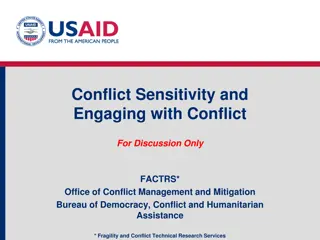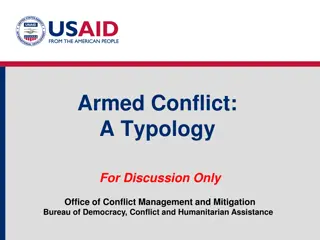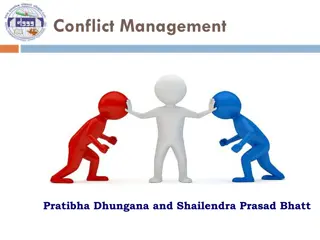Understanding the Role of Culture in Conflict Management and Negotiations
Exploring the impact of culture on conflict management and negotiations, this presentation by Tarmo Tuisk delves into the influence of cultural differences on communication, behavior, and hidden codes. It highlights the importance of understanding fast and slow messages, high and low context cultures, space, time, and the distinction between monochronic and polychronic individuals in cross-cultural interactions.
Download Presentation

Please find below an Image/Link to download the presentation.
The content on the website is provided AS IS for your information and personal use only. It may not be sold, licensed, or shared on other websites without obtaining consent from the author. Download presentation by click this link. If you encounter any issues during the download, it is possible that the publisher has removed the file from their server.
E N D
Presentation Transcript
The Role of Culture in Conflict Management and Negotiations Tarmo Tuisk Tallinn University of Technology 28.07.2017
Agenda Understanding cultural differences Fast and slow messages High and low context cultures Space and time Monochronic people and polychronic people 2
Understanding cultural differences Even though culture is perceived personally, it is nonetheless a shared system. As culture is experienced personally, very few individuals see for what it is a program of behaviour. Members of a common culture not only share information, but also methods of coding, storing and retrieving of that information. These methods vary from culture to culture. 3
Cultural differences hidden? Knowing what kind of information people from other cultures require is one key to effective international communication. Hidden codes of behaviour need code breaker to be understood. 90% or more of all communication is in culture s nonverbal messages (i.e. not language). 4
Culture is communication - Each cultural world operates according to its own internal dynamic, principles and laws (written & unwritten), also time and space. - But common for each culture are: words, material things and behaviour. - Words: medium of business, politics and diplomacy - Material things: indicators of status and power - Behaviour: feedback about people feel and includes techniques to avoid confrontation. 5
Silent language human behaviour that exists outside conscious awareness. includes evolutionary concepts, practices, solutions to problems, shared experience of ordinary people. Provides insights into the underlying principles that shape our lives. These principles are not merely interesting, but eminently practical. 6
Fast and slow messages Cross-cultural communication has more to do with releasing right responses than sending right messages. Information can be sent in different speed. A fast message to them who have used to have it in slow format will miss the target. Although people can understand the content of wrong-speed message, for them who expect it in different speed it won t be understandable. People are not (always) aware that the information can be sent in different speeds. 7
Fast and Slow Messages Almost everything in life can be placed somewhere within fast/slow message spectrum. Slow mode: research, diplomacy, writing books, creating art. Messages of Buddha, Confucius, Goethe, Rembrandt are still now hundreads of years after the fact under deciphering by human beings. Very slow messages: a person, a language, and culture incorporating multiple styles of languages where messages are released for them who are willing to spend time to understand it. 9
High and Low Context Context the information that surrounds the event. The elements that combine to produce a given meaning events and context are in different proportions depending on the culture. High context (HC) communication or message is the one where most of the information is already on the person, and very little is in the coded, explicit, transmitted part of the message (e.g. twins communicating with each other). Low context (LC) the mass of the information is vested in the explicit code (e.g. two lawyers in the courtroom during a trial). 10
HC people and LC people HC people: Japanese, Arabs, Mediterranean. (having extensive information networks among family, friends, colleagues, clients. Beacuse of daily information exchange their messages are high- context). LC people: Americans, Swiss, Germans, Scandinavians, other Northern Europeans. Example: The French are much higher on the context scale than either Germans or Americans. 11
Space Territoriality e.g. what is mine for Germans is not percieved the same way for Americans (e.g. touching a car..). Space communicates power (e.g. location of the boss in the office). Personal Space a bubble around a person (North vs. South) Unconsious Reactions to Spatial Differences 12
Personal territory Intimate distance for embracing, touching or whispering. Personal distance for interactions among good friends or family members. Social distance for interactions among acquaintances. Public distance used for public speaking. Realizing and recognizing these cultural differences improves cross-cultural understanding, and helps people to eliminate discomfort feeling if the interpersonal distance is too large ("stand-offish") or too small (intrusive).
Time Monochronic and Polychronic Time Monochronic paying attention and doing only one thing at a time. Time is experianced and used in a linear way. Perceived as tangible: spent , wasted , saved and lost . Polychronic simultaneus occurance of many things by great involvement of people. More emphasis on completing human actions than meeting the schedules. 16
Relation between Time and Space MT culture: emphasis is on the compartmentalization of functions and people (e.g. private offices are soundproof). PT culture: business offices with large reception areas; polychronic people feel that private space disrupts the flow of information; appointments mean very little and may be shifted around at the last minute in the sake of someone who is more important in individual s hierarchy of family, friends or associates. NB! Monocrhonic vs Polychronic Time culture this dichotomy cannot be overemphasizied. 19
Time as Communication Tempo, Rhythm, Synchrony: (e.g. Americans complain: Germans take forever to reach decisions) There is a need to be contexted to local time system. Scheduling and Lead Time USA and Germany: schedules are sacred. Short lead time means the business is less important (e.g. in Germany two weeks minimum, in Arabic culture 3-4 days is sufficient). 22
The Importance of Proper Timing Announcements of major changes must be carefully timed. USA and northern Europe: anything that occurs outside business hours refers to emergency . E.g. in August in France everything shuts down for vacances. Common in US is short lunch vs. longer dinner in France to get acquinted with business partners. 23
Appointments Long waiting-time in the U.S. and Germany: a delibarate putdown and/or a message about the individual being very disorganized. In France: no such message is intended. Interactions between monochronic and polychronic people can be stressful unless both parties know and decode the meanings behind each other s language and time. 24
Action Chains: The importance of completition Monochronic low-context cultures: compartmentized approach and dependence on schedules are more sensitive to interrputions, and more vulnarable to the breaking of action chains compared to high- context cultures. High-context people are more elastic because of their extensive and cohesive networks in their system. 25
Action chains and disputes All cultures have in-built safeguards to prevent a dispute from escalating. These safeguards apply only within the context of one s own culture. In foreign situation where a dispute appears imminent it is essential to do two things: Proceed slowly, taking every action possible to maintain course; Seek the advice of a skillful, tactful interpreter of the culture a mediator. 1) 2) 26
Summary Understanding High Context and Low Context cultures and their differences Monochronic and Polychronic Time cultures Speed of messages Context Space and time Action chains All these are essential to understand in situations of conflict management and during negotiations. In each cultural context all acts, all events and all material things have meaning. 27
Literature Hall, E. T., Hall, M. R. (1990). Understanding Cultural Differences. Intercultural Press. Hall, E. T. (1973/1990). The Silent Language. Anchor Books Editions : New York Hall, E. T. (1977/1989). Beyond Culture. Anchor Books Editions : New York. 28

























